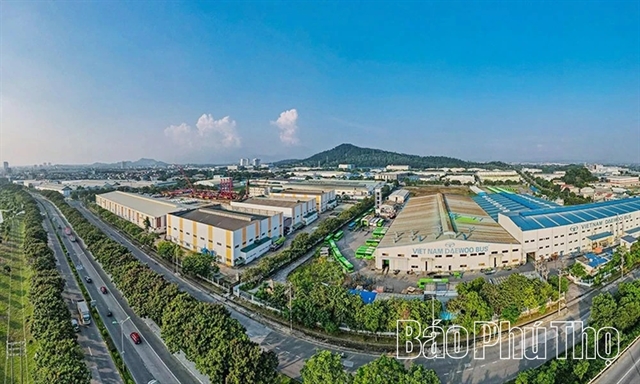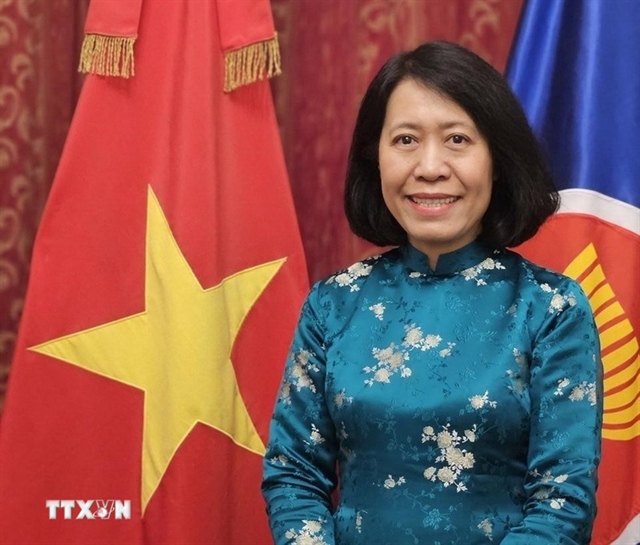 Sunday/Weekend
Sunday/Weekend

Công Thành
 |
| A boy joins a mangrove-growing trip in Lạc Hòa Commune of Sóc Trăng Province's Vĩnh Châu Town. The Forest Symphony project raised fund from community to plant 20.5ha of mangrove forest in Sóc Trăng, and another 100ha forest in Ninh Thuận Province in 2021-22. — Photo courtesy of Sống Foundation |
More than 81,000 mangrove trees have been planted by local residents and volunteers to form a ‘green’ dyke system, creating a sustainable farming area for a 7,000-population community in the Mekong Delta province of Sóc Trăng's Vĩnh Châu town.
The 20ha Symphony Forest project has increased its survival ratio to 92 per cent, filling the forest blanket area with an alluvial embankment along coastal Lạc Hòa Commune and providing a livable habitat for the local community and nature.
The community’s own labour force and volunteers also completed a 2.5km bamboo fence as a water breaker for 44,000 trees on another 10ha mangrove forest in 2023, and are aiming for an overall target of 50ha by 2025.
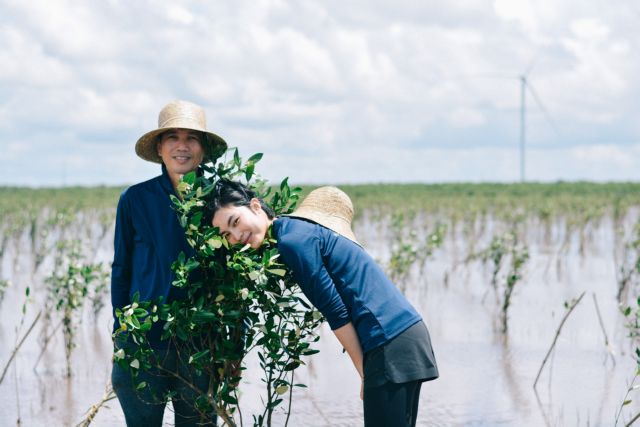 |
| Actress-model Tống Khánh Linh (right) takes part in planting mangroves in the Mekong Delta province of Sóc Trăng. The forest was grown with crowd funding in 2021-22. — Photo courtesy of Forest Symphony |
Phạm Thị Hương Giang, the founder and chairwoman of the Sống Foundation that fundraises for the project, said the mangrove afforestation in Lạc Hoà was one of two key parts of the Symphony Forest project that includes 250ha of rocks and bare land area on the coast of the south-central province of Ninh Thuận .
“We aim to set up a typical sustainable afforestation project that involves plantation, care and supervision in a strict five-year plan across multiple sectors. The plan will ensure saplings grow strongly on a solid alluvial ground, which could actually work as a green protective dyke for the local community and help them generate incomes,” Giang said.
“Our project has raised funds from the community, organisations and individuals to build a harmonious link between people, nature and green space, creating a 'forest symphony'.
“The purpose of the fund is to achieve better environmental outcomes through planting new forests. Whether it is water preservation, carbon absorption or reducing land erosion, the scheme will make a real difference to our province’s future."
The 44-year-old said each donation of VNĐ90,000 meant a tree would be planted and cared for over a five-year period in the coastal mangrove forest in Vĩnh Châu Town and would contribute to a sustainable future for the Mekong Delta.
Trương Văn Vinh, an expert from HCM City-based Agriculture and Forestry Institute, said the forest could provide ecological services and livelihoods for the forest-based community.
“Mangrove forests can help communities in the coastal areas be resilient to climate change as it could protect them from the consequences of landslides, high tides, floods and big storms,” Vinh said.
“The wetland forest will create a fresh environment and ease saline intrusion in the area, while building a natural shelter for seafood species and an income for local residents.”
Vinh said less damage from natural disasters would help the local community preserve their traditional fisheries and crafts related to the mangrove forest.
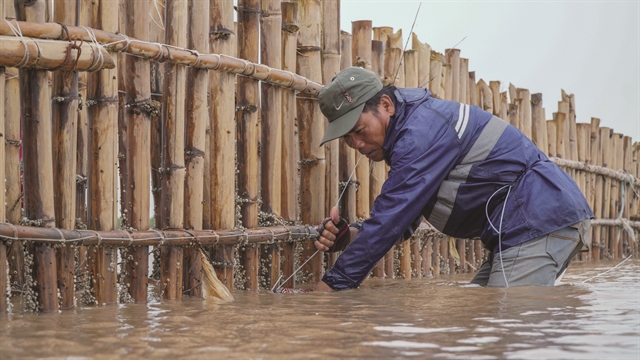 |
| A local farmer checks a bamboo fence in the wet-land area of Lạc Hòa Commune of Sóc Trăng Province. Volunteers and local residents have planted nearly 20ha of mangroves in the area. — Photo courtesy of Green Happiness |
The mangrove afforestation has engaged local residents since they were aware of the importance of the ‘green’ shield and prolonged the livelihood of wetland-based life for generations.
Sơn Túp, an ethnic Khmer man, who has 20-years of experience in planting mangrove forests in Lạc Hoà Commune, said the mangrove played a key role in fighting natural disasters.
“Mangrove forest naturally breaks flood water and high tides during the monsoon and rough wind season. Large waves and a long time soaking in water are major reasons for heavy erosion at the soil dyke. This means our rice crops will be completely damaged by flooding water,” he said.
“Salt water intrusion adds to crop loss in the mangrove forest area. So, wetland forest is one of the most effective solutions in reducing erosion.”
He said a community-based afforestation team of 40-members was assigned to regular checks of the newly grown mangrove saplings.
Kim Nạng, a member of the forest project, said the mangroves helped strengthen soil structure with its network of tree roots.
“Thicker layers of alluvium leave the dyke protected enough from rough seas and large waves. Mangrove forests prevent high water breaking, and crop land will not be intruded and become salty,” he said.
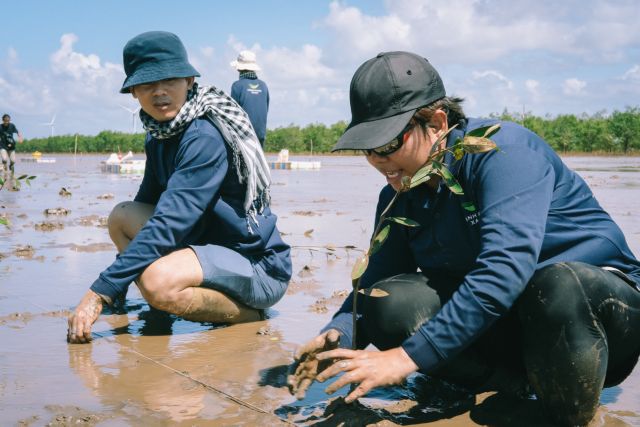 |
| Volunteers plant mangrove saplings on alluvial marshes in the coastal town of Vĩnh Châu. — Photo courtesy of Sống Foundation |
He said groups of 10 or 20 did daily checks on the growth of saplings and clear any dangers to the newly planted mangroves.
“Twenty to 30 per cent of the saplings will die if they do not receive proper care in two or three months after planting. We can also earn extra income from seafood catches during our forest tending and allowance from afforestation,” Nạng said.
He said high-value species including oysters, fish and crabs were found living on sandbanks in the forest.
Trần Vũ Khánh Linh, a managing member of the project, said he had followed the project from the very start.
“It’s not easy. The forest trip takes us hours, wading through 3km of mud marsh doing surveys and mangrove tending. However, we are supported by the local community in sharing experience and on how to grow the mangroves best,” Linh said.
“We are so happy to see mangrove saplings growing well with daily care and love from the local farmers.”
Linh said the project used IT applications including Geographic Information Systems, drone, and remote sensing techniques in monitoring the quality of the forest as well as forecast system installation warning of any possible natural disasters.
The founder of the Forest Symphony project has been calling for donations from the community in expanding afforestation across Ninh Thuận Province – where about 97,000 trees were planted over 100ha of marshy land in the last 10 years or so.
Giang said the ecosystem in the sand dunes and rocky land areas – which were previously destroyed by over-logging for firewood – had been visibly restored by the green shadow of trees, shrubs and weeds.
“We hope underwater reserves in the area will refill from the afforestation project and the strong determination of the community and local authorities in expanding the forest area over the next few years,” Giang said.
“It needs joint-hand actions from the community’s fund-raiser for the Forest Symphony project. Donations from any event can help the project grow more trees in Sóc Trăng and Ninh Thuận.”
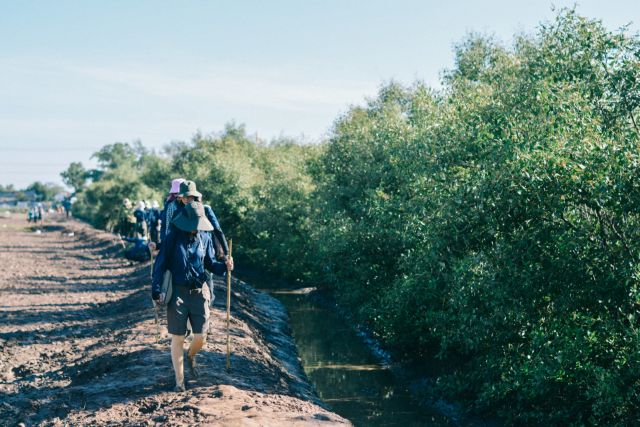 |
| Local residents and volunteers trek in the newly planted mangrove forest in Sóc Trăng province. Tree-planting trips are included in a series of actions in the mangrove afforestation project by Sống Foundation in 2021-23. — Photo courtesy of Forest Symphony |
“An auction of a painting can provide a fund for growing more than 2,000 trees in the project as the cost for planting and tending a tree is only about VNĐ90,000 over five years,” she said.
Since 2021, the New Zealand Embassy in Việt Nam has provided financial support for the Sống Foundation to plant 10,000 trees in the two provinces.
“The New Zealand Embassy is proud to be part of a project that will see an estimated 3ha of forest planted in Ninh Thuận Province. Reforestation is critical to our planet’s long term health and this is a fantastic result for Ninh Thuận,” said Tredene Dobson, New Zealand ambassador to Việt Nam, at the start of the project.
Staff members of PricewaterhouseCoopers – a global consulting company – also contributed funds and labour to grow 1,000 mangroves in Sóc Trăng.
“We expect that the Forest Symphony project under the ‘green happiness programme' will be a way for all donors to contribute little efforts in building a larger ‘green and fresh’ natural landscape and forest canopy habitat for both people and wildlife,” Giang added. — VNS


